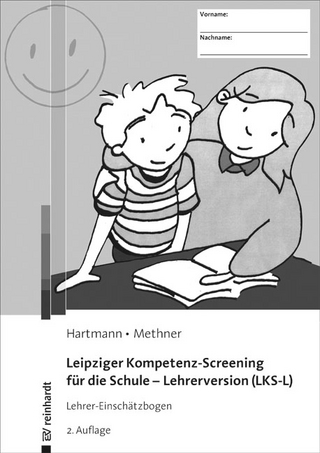
Characteristics of Emotional and Behavioral Disorders of Children and Youth, with Enhanced Pearson eText -- Access Card Package
Pearson Education (US)
978-0-13-446061-1 (ISBN)
A coherent conceptualization of the problems of students with Emotional and Behavioral Disorders (EBD) and their challenges for teachers.
The Eleventh Edition of Characteristics of Emotional and Behavioral Disorders of Children and Youth follows the text's long-standing reputation for trusted research, a teacher-focused presentation, and clear explanations of the concepts related to students with Emotional and Behavioral Disorders (EBD). Organized around major concepts in four logical parts, the text helps readers understand the background of EBD, the origins of behavior disorders, the types of behavior disorders, and the procedures associated with the assessment of these disorders. The teacher-focused presentation offers a sound conceptualization of the problems that students with EBD encounter and the common challenges for their teachers. Case studies, Personal Reflections, and Questions for Reflection features launch readers into self-questioning and prompt them to think critically about behavior and its contexts. This edition includes new references, new Personal Reflections, reorganized chapters for a more effective flow of content, and more detailed coverage of assessment.
Invigorate learning with the Enhanced Pearson eText
The Enhanced Pearson eText provides a rich, interactive learning environment designed to improve student mastery of content with links to embedded videos and end of chapter quizzes. The Enhanced Pearson eText is also available without a print version of the textbook.
Instructors, visit pearsonhighered.com/etextbooks/ted to register for your digital examination copy. Students, register for or purchase your eText at pearsonhighered.com/etextbooks/ted.
James M. Kauffman is Professor Emeritus of education at the University of Virginia, where he was a faculty member for more than 30 years. He is also a former teacher of special education for students with emotional and behavioral disorders. He is the author, co-author, and co-editor of many publications in special education.
Brief Table of Contents
PART I: POINTS OF DEPARTURE
1. Beginning Point: Basic Assumptions
2. What We’re About: The Problem and Its Size
3. Where We Started and Where We’re Going: Past, Present, Future
PART II: POSSIBLE CAUSES
4. Biology
5. Culture
6. Family
7. School
PART III: TYPES OF DISORDERED BEHAVIOR
8. Attention and Activity Disorders
9. Conduct Disorders
10. Anxiety and Related Disorders
11. Depression and Suicidal Behavior
12. Disorders of Thinking, Communication, and Stereotypical Behavior
13. Special Problems of Adolescents
PART IV: ASSESSMENT
14. Measurement Issues, Screening, and Identification
15. Assessment for Instruction
Detailed Table of Contents
PART I: POINTS OF DEPARTURE
1. Beginning Point: Basic Assumptions
Thinking about the Problem
Brief Descriptions of Four Conceptual Models
Choosing Models
An Integrated, Social-Cognitive Model
Good Teaching
Interrelationships Among Causes, Types of Behavior, Assessment, and Intervention
Summary
Cases for Discussion
Questions About the Cases
2. What We’re About: The Problem and Its Size
Common Terminology
Definition
Importance of Definition
Prevalence
Factors Affecting Prevalence
Summary
Case for Discussion
Questions About the Case
3. Where We Started and Where We’re Going: Past, Present, Future
A Brief History of the Field
Issues of the 21st Century
Legal Developments and Issues
Past and Future
Summary
Case for Discussion
Questions About the Case
PART II: POSSIBLE CAUSES
4. Biology
The Appeal of Biological Factors as Causal Explanations
Genetics
Brain Damage or Dysfunction
Nutrition, Allergies, and Other Health Factors
Implications for Educators
Summary
Case for Discussion
Questions About the Case
5. Culture
The Appeal of Cultural Factors as Causal Explanations
Conflicting Cultural Values and Standards
Multicultural Perspective
Problems in Evaluating Cultural Factors
Implications for Educators
Summary
Case for Discussion
Questions About the Case
6. Family
The Appeal of Family Factors as Causal Explanations
Family Definition and Structure
Family Interaction
External Pressures Affecting Families
Implications for Educators
7. School
The Appeal of School Factors as Causal Explanations
Intelligence
Academic Achievement
Social Skills
Intelligence, Achievement, and Antisocial Behavior
Schools’ Contribution to Emotional and Behavioral Disorders
Implications for Educators
Biology, Culture, Family, and School: A Tangled Web
Summary
Case for Discussion
Questions About the Case
PART III: TYPES OF DISORDERED BEHAVIOR
8. Attention and Activity Disorders
Definition and Prevalence
Causal Factors and Prevention
Assessment
Intervention and Education
A Perspective on Intervention
Summary
Personal Reflections
Questions for Further Reflection
9. Conduct Disorders
Definition, Prevalence, and Classification
Aggression and Violence in Social Context
Causal Factors
Assessment
Intervention and Education
Summary
Personal Reflections
Questions for Further Reflection
10. Anxiety and Related Disorders
Anxiety Disorders
Eating Disorders
Elimination Disorders
Sexual Problems
Social Isolation and Ineptitude
Causal Factors and Prevention
Assessment
Intervention and Education
Summary
Personal Reflections
Questions for Further Reflection
11. Depression and Suicidal Behavior
Depression
Suicidal Behavior
Summary
Personal Reflections
Questions for Further Reflection
12. Disorders of Thinking, Communication, and Stereotypical Behavior
Schizophrenia
Socialization Problems
Communication Disorders
Stereotypy (Abnormal Repetitive Movement)
Summary
Personal Reflections
Questions for Further Reflection
13. Special Problems of Adolescents
Problem Behaviors in Adolescence and Early Childhood
Juvenile Delinquency
Substance Abuse
Early Sexual Activity and Teen Parenthood
Summary
Personal Reflections
Questions for Further Reflection
PART IV: ASSESSMENT
14. Measurement Issues, Screening, and Identification
General Rules for Evaluation for Special Education
General Criteria for Acceptable Assessments
Prereferral Strategies and Response to Intervention
Evaluation for Eligibility
Summary
15. Assessment for Instruction
Assessment for Instruction
Current Trends in Educational Assessment for Instruction
Evaluation for Instruction and Other Interventions
Manifestation Determination
Functional Behavioral Assessment
Adaptations for Inclusion in General Education Assessments
Evaluation and Social Validation
Use of Evaluation Data in Writing Individual Education Programs
Classification
Necessity of Classification
Summary
Case for Discussion
Questions About the Case
Personal Reflections
Questions for Further Reflection
| Erscheint lt. Verlag | 23.4.2017 |
|---|---|
| Verlagsort | Upper Saddle River |
| Sprache | englisch |
| Maße | 195 x 244 mm |
| Themenwelt | Sozialwissenschaften ► Pädagogik ► Sonder-, Heil- und Förderpädagogik |
| ISBN-10 | 0-13-446061-8 / 0134460618 |
| ISBN-13 | 978-0-13-446061-1 / 9780134460611 |
| Zustand | Neuware |
| Haben Sie eine Frage zum Produkt? |
aus dem Bereich


